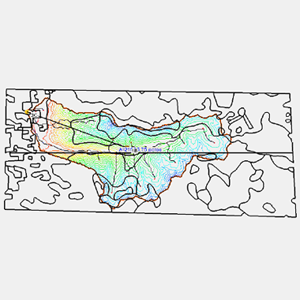We use cookies to make your experience better. To comply with the new e-Privacy directive, we need to ask for your consent to set the cookies. Learn more.
HSPF
Modeling Short or Long-term Watershed Quantity & Quality for Small or Large Watersheds

Application:Water Quality & Hydrologic Modeling
Method:Lumped Parameter
Model Type:1D
Developer:U.S. Geological Survey
Why HSPF with WMS?
WMS provides a custom interface to the HSPF model offering a simple way to set model parameters and a graphical user interface to run the model and visualize the results. Gather background data from a variety of sources from GIS to CAD and access online data from numerous databases of maps, images, elevation, land use, and soil data. WMS allows you to interact with models in true 3D taking advantage of optimized OpenGL graphics and to create photo-realistic renderings and animations for PowerPoint, print, and web presentations.
Try WMS Free for 14 Days >Purchase WMS with HSPF >
HSPF Description:
Developed by the USGS and EPA, the Hydrologic Simulation Program - FORTRAN (HSPF) simulates hydrologic and waterquality processes on land surfaces, streams, and impoundments. HSPF is generally used to perform a watershed-based analysis of the effects of land use, reservoir operations, point and nonpoint source treatment alternatives, flow diversions, etc. It is accepted by the EPA as a tool for the development of TMDLs in the United States.
HSPF simulates for extended periods of time the hydrologic, and associated water quality, processes on pervious and impervious land surfaces and in streams and well-mixed impoundments. HSPF uses continuous rainfall and other meteorologic records to compute streamflow hydrographs and pollutographs. HSPF simulates interception soil moisture, surface runoff, interflow, base flow, snowpack depth and water content, snowmelt, evapotranspiration, ground-water recharge, dissolved oxygen, biochemical oxygen demand (BOD), temperature, pesticides, conservatives, fecal coliforms, sediment detachment and transport, sediment routing by particle size, channel routing, reservoir routing, constituent routing, pH, ammonia, nitrite-nitrate, organic nitrogen, orthophosphate, organic phosphorus, phytoplankton, and zooplankton. Program can simulate one or many pervious or impervious unit areas discharging to one or many river reaches or reservoirs. Frequency-duration analysis can be done for any time series. Any time step from 1 minute to 1 day that divides equally into 1 day can be used. Any period from a few minutes to hundreds of years may be simulated. HSPF is generally used to assess the effects of land-use change, reservoir operations, point or nonpoint source treatment alternatives, flow diversions, etc. Programs, available separately, support data preprocessing and postprocessing for statistical and graphical analysis of data saved to the Watershed Data Management (WDM) file.
The model contains hundreds of process algorithms developed from theory, laboratory experiments, and empirical relations from instrumented watersheds.
The model was developed in the early 1960's as the Stanford Watershed Model. In the 1970's, water-quality processes were added. Development of a Fortran version incorporating several related models using software engineering design and development concepts was funded by the Athens, Ga., Research Lab of EPA in the late 1970's. In the 1980's, preprocessing and postprocessing software, algorithm enhancements, and use of the USGS WDM system were developed jointly by the USGS and EPA.
